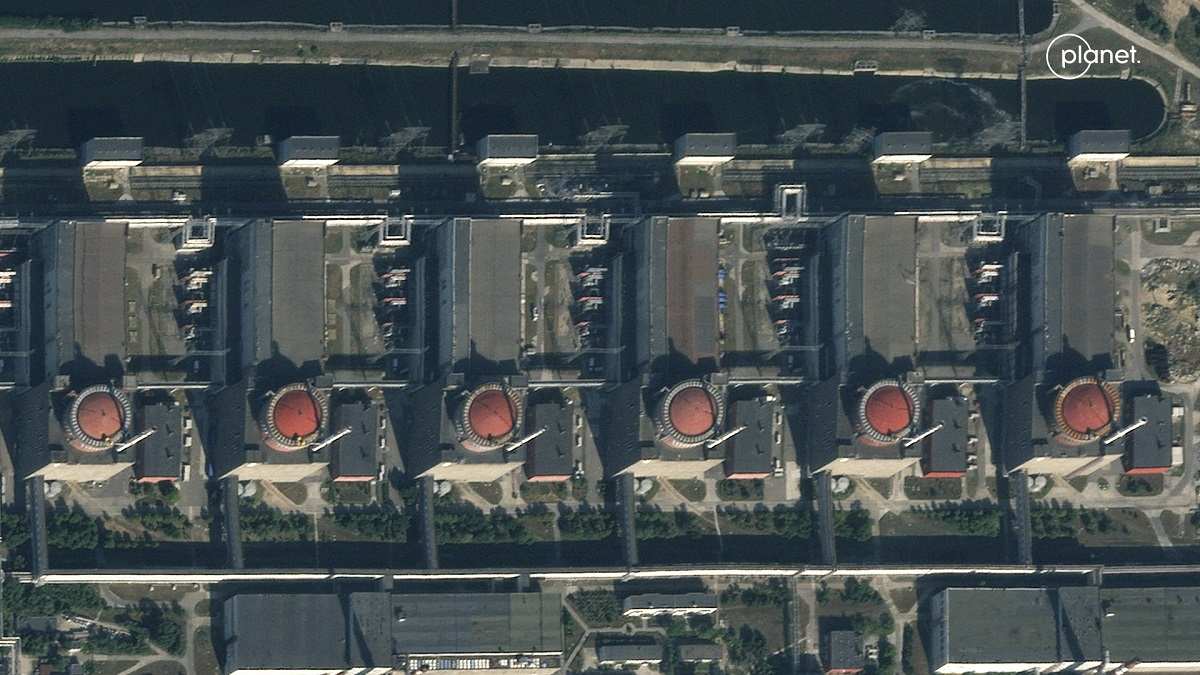Ukraine, Russia Accuse Each Other of Planning to Attack Europe’s Biggest Nuclear Plant

This image provided by Planet Labs PBC shows the Zaporizhzhia Nuclear Power Plant in Southern Ukraine on Wednesday, July 5, 2023.
11:00 JST, July 6, 2023
KYIV, Ukraine (AP) — Ukraine and Russia accused each other Wednesday of planning to attack one of the world’s largest nuclear power plants, but neither side provided evidence to support their claims of an imminent threat to the facility in southeastern Ukraine that is occupied by Russian troops.
The Zaporizhzhia Nuclear Power Plant has been a focus of fear since Moscow’s forces took control of it early in the war. Ever since then, Moscow and Kyiv have traded blame for shelling the facility and accused each other of nuclear terrorism.
Regular power outages resulting from shelling made it impossible to operate the plant safely, and its six reactors have been shut down to minimize the threat of a disaster.
Over the last year, the U.N.’s atomic watchdog repeatedly expressed alarm over the possibility of a radiation catastrophe like the one at Chernobyl after a reactor exploded in 1986.
Ukraine has alleged more recently that Moscow might try to cause a deliberate leak in an attempt to derail Kyiv’s ongoing counteroffensive in the surrounding Zaporizhzhia region. Ukrainian authorities accused Russia of blowing up a dam in southern Ukraine last month with a similar aim, while Moscow blamed Ukraine for its destruction.
Citing the latest intelligence reports, Ukrainian President Volodymyr Zelenskyy alleged Tuesday night that Russian troops had placed “objects resembling explosives” on top of several of the plant’s power units to “simulate” an attack from outside.
“Their detonation should not damage power units but may create a picture of shelling from Ukraine,” according to a statement from the general staff of Ukraine’s armed forces.
The Associated Press reviewed high-resolution satellite imagery of the plant taken Monday and Wednesday. The photos showed no visible changes to the roofs of the six concrete containment domes covering the reactors at the plant, or nearby buildings.
The International Atomic Energy Agency has officials stationed at the Russian-held plant, which is still run by a Ukrainian staff that oversees crucial cooling systems and other safety features.
The facility’s location in an area of intense fighting has put it at the mercy of stray shells or rockets, and the Russia-ordered evacuation of hundreds of local people in May deepened the anxiety. The IAEA has tried in vain to forge a deal on a security zone around the plant.
IAEA Director General Rafael Mariano Grossi said his agency’s most recent inspection of the plant found no activity related to explosives, “but we remain extremely alert.”
“As you know, there is a lot of combat. I have been there a few weeks ago, and there is contact there very close to the plant, so we cannot relax,” Grossi said during a visit to Japan.
Agency experts have requested additional access to the rooftops of two reactor units, as well as turbine halls and some parts of the cooling system at the plant to confirm the absence of explosives.
“Our experts must be able to verify the facts on the ground. Their independent and objective reporting would help clarify the current situation at the site, which is crucial at a time like this, with unconfirmed allegations and counter allegations,” Grossi said in a statement.
In Russia, Kremlin spokesman Dmitry Peskov raised the specter of a potentially “catastrophic” provocation by the Ukrainian army at the nuclear plant, which is Europe’s largest.
“The situation is quite tense. There is a great threat of sabotage by the Kyiv regime, which can be catastrophic in its consequences,” Peskov said in response to a reporter’s question about the plant. He also claimed that the Kremlin was pursuing “all measures” to counter the alleged Ukrainian threat.
Renat Karchaa, an adviser to Russian state nuclear company Rosenergoatom that controls the plant, said there was “no basis” for Zelenskyy’s claims of a plot to simulate an explosion. “Why would we need explosives there? This is nonsense” aimed at “maintaining tension,” Karchaa said Wednesday, according to the Interfax news agency.
Late Tuesday, Karchaa alleged in televised remarks that Ukraine’s military was planning to strike the plant overnight with ammunition laced with nuclear waste, but no such attack came.
Grossi said he was aware of both Kyiv’s and Moscow’s claims and reiterated that “nuclear power plants should never, under any circumstances, be attacked.”
“A nuclear power plant should not be used as a military base,” he said.
Last week, Ukrainian emergency workers held a drill to prepare for a potential release of radiation from the plant. In case of a nuclear disaster at the plant, approximately 300,000 people would be evacuated from the areas closest to the facility, according to the country’s emergency services.
Ukrainian officials have said the shut-down reactors are protected by thick concrete containment domes, and experts have said that the plant’s design allows it to withstand barrages.
A Russian attack on the plant would “probably not lead to the widespread dispersal of significant amounts of radiation” due to precautionary steps taken by the IAEA, according to the International Institute for Strategic Studies, a think tank.
“A blast at Zaporizhzhia would spread radiation and sow panic, but the actual off-site radiation risk would be relatively low,” the think tank said in a recent assessment, adding that wind might blow some radiation toward Russia.
The IISS charged that the most likely scenarios are a Russian-engineered explosion that exposes one of the reactor cores and starts a fire that burns spent fuel, or a blast involving the dry spent fuel on site that would carry the radiation far afield via wind. Neither of those scenarios would bring a disaster on the scale of Chernobyl or Fukushima, Japan’s tsunami-wrecked nuclear plant, it said.
Mark Wenman, a nuclear expert with London’s Imperial College, emphasized that the reactor containment buildings are robust, made from heavily reinforced concrete that is 1.2 meters (4 feet) thick and able to withstand earthquakes and aircraft impacts.
Because the plant’s reactors have been shut down for months, they are not generating much heat anymore, and the spent fuel held in cooling ponds is protected by the concrete containment structure, Wenman said.
Any cold fuel, which is stored in concrete and steel containers outside, is too cold to heat itself and cause a radioactive release, he added.
“It would take a very concerted effort to damage the containment building and cause any form of radioactive release from within,” Wenman said in a commentary. “Even then, the most notable isotope of concern to humans, iodine-131, has all gone due to the time elapsed since the reactors were operational. Overall the risks are still very small.”
"News Services" POPULAR ARTICLE
-

American Playwright Jeremy O. Harris Arrested in Japan on Alleged Drug Smuggling
-

Japan’s Nikkei Stock Average as JGB Yields, Yen Rise on Rate-Hike Bets
-

Japan’s Nikkei Stock Average Licks Wounds after Selloff Sparked by BOJ Hike Bets (UPDATE 1)
-

Japan’s Nikkei Stock Average Buoyed by Stable Yen; SoftBank’s Slide Caps Gains (UPDATE 1)
-

Japanese Bond Yields Zoom, Stocks Slide as Rate Hike Looms
JN ACCESS RANKING
-

Keidanren Chairman Yoshinobu Tsutsui Visits Kashiwazaki-Kariwa Nuclear Power Plant; Inspects New Emergency Safety System
-

Imports of Rare Earths from China Facing Delays, May Be Caused by Deterioration of Japan-China Relations
-

University of Tokyo Professor Discusses Japanese Economic Security in Interview Ahead of Forum
-

Tokyo Economic Security Forum to Hold Inaugural Meeting Amid Tense Global Environment
-

Japan Pulls out of Vietnam Nuclear Project, Complicating Hanoi’s Power Plans


























